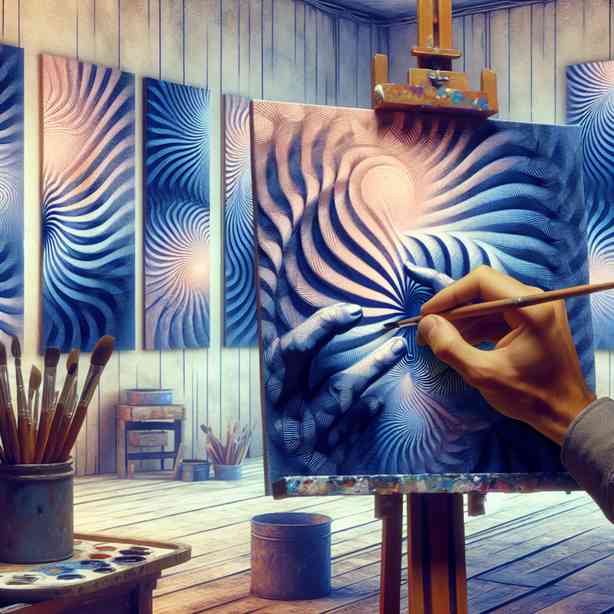
When Painting Becomes Repetition—In a Good Way
Art has always been a canvas for expression, emotion, and creativity. Yet, as we delve deeper into the realm of painting, we often encounter the concept of repetition. At first glance, repetition may seem to inhibit creativity or lead to monotony. However, upon closer examination, one can argue that repetition in painting can serve as a powerful tool for mastery, exploration, and profound artistic expression. In this discussion, we will explore the various dimensions of how repetition can enhance the act of painting, making it a process of growth and discovery.
To begin with, let us consider the idea of practice in the world of art. Every artist, regardless of their medium, understands the importance of consistent practice. Repeating specific techniques or themes allows artists to hone their skills and gain insights that they might overlook in a single, spontaneous attempt. Just as musicians practice scales or athletes repeat drills, visual artists benefit from the repetitive exploration of specific concepts or motifs. This repetition leads to improved techniques and fosters a deeper understanding of the medium itself. Thus, the first positive aspect of repetition in painting lies in its potential for skill enhancement.
Moreover, repetition can foster a sense of discipline and commitment. By engaging with similar themes or techniques over extended periods, artists cultivate focus and dedication. This structured approach allows for personal development and transformation. When artists commit to a series of works centered around a particular subject, they often discover new facets of their creative voice. They may explore various angles, colors, and emotions associated with the chosen theme, leading to innovative outcomes that are richer and more nuanced. In this sense, repetition becomes a pathway for exploration rather than a limitation.
In addition to personal growth, the impact of repetition can also be observed in the emotional resonance of art. Selective repetition can create patterns that evoke familiarity, which can resonate with viewers on an emotional level. Think of the works of notable artists like Yayoi Kusama, whose repetitive dot patterns are not merely decorative but serve to convey complex themes of infinity, obsession, and the intricacies of human experience. Such repetition draws viewers into a collective experience, inviting them to reflect on their interpretations and emotional responses. This dimension of art emphasizes that repetition, when crafted thoughtfully, leads to deeper connections with the audience.
Furthermore, we can also examine how cultural and historical contexts influence the use of repetition in painting. Throughout history, many cultures have embraced repetition as a fundamental aspect of artistic practice. In traditional Japanese sumi-e (ink wash) painting, for instance, artists often repeat specific brushstrokes to convey movement and life within a simple composition. Similarly, Aboriginal art frequently incorporates repetitive patterns and symbols that hold significant cultural meaning, serving as visual narratives of history and spirituality. By drawing on such traditions, contemporary artists can reinterpret these practices, finding fresh relevance and connection in their own work while paying homage to the past.
In contemporary art, repetition has evolved into a theme in itself. Artists like Andy Warhol, known for his repetition of subjects through silkscreen printing, questioned notions of originality and consumer culture. His work invites commentary on mass production and the ubiquity of images in a media-saturated society. In this context, repetition transcends merely being a technique; it becomes a conceptual framework that challenges viewers’ perceptions and engages them in a dialogue about art’s role in society.
As we explore the layers of meaning associated with repetition in painting, it’s also essential to acknowledge the psychological aspects involved. The human brain responds to patterns, and repetition can create a sense of comfort and predictability. This psychological response can be harnessed by artists to build an atmosphere in their work. Repetitive elements can evoke tranquility, chaos, or even tension, depending on how they are manipulated. By thoughtfully introducing repetition into their compositions, artists can effectively guide the viewer’s emotional journey, enhancing the overall impact of the piece.
Additionally, the role of technology in contemporary painting introduces new avenues for repetition. Digital tools allow artists to replicate and manipulate images effortlessly, blurring the lines between original and reproduced works. This technological revolution offers exciting opportunities for artists to explore themes of repetition in innovative ways. As artists experiment with new digital mediums, they find new ways to engage with traditional concepts, merging the old with the new in a distinctively modern context.
Nevertheless, it is essential to strike a balance when embracing repetition in painting. While it can be a source of depth and exploration, over-repetition may lead to stagnation or a sense of artistic fatigue. Artists must remain mindful of their creative intentions, ensuring that repetitive elements serve a purpose rather than detract from the overall vision. This mindfulness not only preserves the integrity of the work but also encourages artists to continually evolve their practice.
In conclusion, repetition in painting is a multifaceted concept that, when embraced thoughtfully, can lead to profound artistic growth and deeper emotional connections with viewers. From honing technical skills to exploring psychological dimensions and cultural narratives, repetition opens doors to new creative paths. By understanding and leveraging the potential of repetition, artists can not only enhance their work but also contribute to a rich dialogue within the art community. Ultimately, repetition does not signify limitation; rather, it represents a journey of discovery, a testament to the ever-evolving nature of artistic expression. Through this lens, one can appreciate how painting transforms into a dialogue of nuances, emotions, and intricate meanings, making the act of repetition a celebration of creativity, mastery, and connection.


